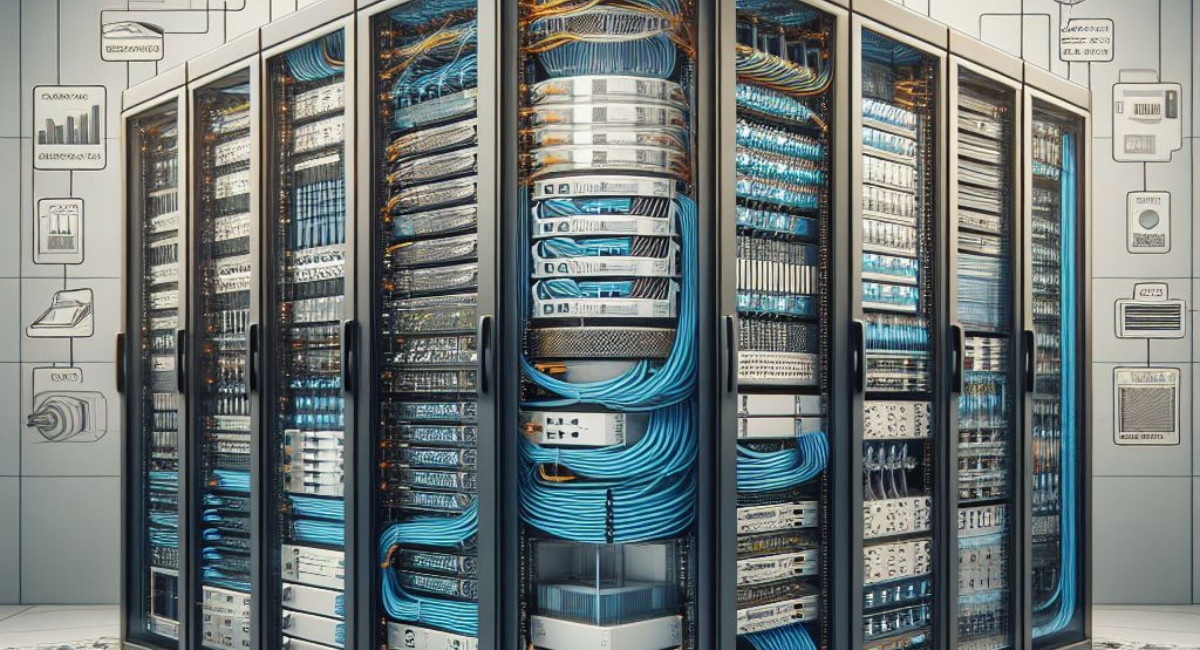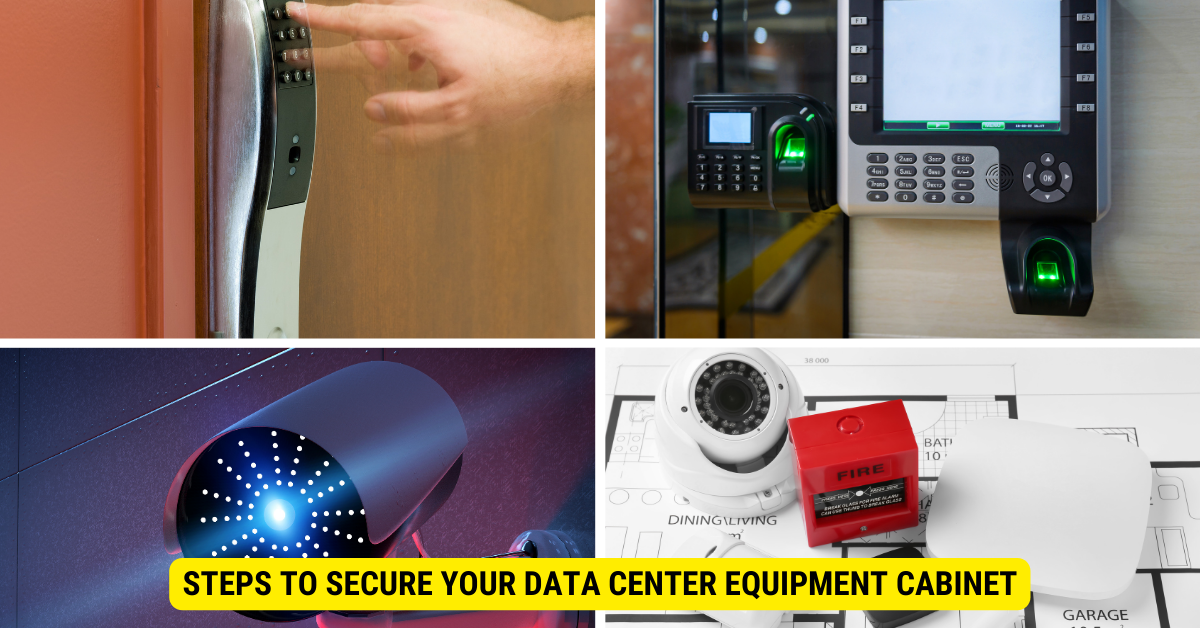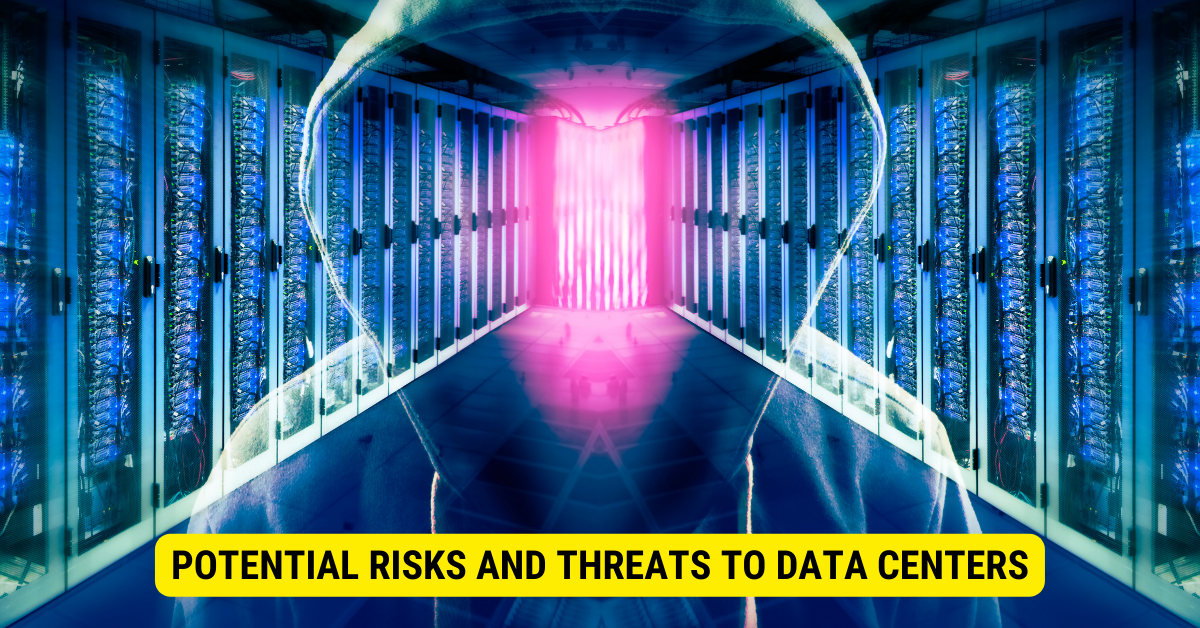To secure a data center equipment cabinet, implement physical security measures such as durable, lockable cabinets, utilize advanced access controls like biometric systems, deploy surveillance tools like CCTV cameras, and consistently monitor and update these measures.
Data centers are critical for any business operation, and protecting them is paramount. The core of this security revolves around the data center equipment cabinet. We will delve into the crucial aspects of securing these equipment cabinets, from understanding their significance and deciphering their components to providing security measures and practices you can apply.
Basics of Data Center Equipment Cabinet
Now that we understand why we need to secure our data centers let’s dive deeper into understanding what a data center cabinet is and its significance in the data center environment.
What is a Data Center Equipment Cabinet?

A data center cabinet, also known as a rack, is a large container or enclosure that houses all the data center’s essential equipment. This includes servers, storage hardware, cables, and other necessary equipment. The cabinet is designed to provide a structured layout for efficient operation, easy management, and enhanced equipment protection.
Imagine a data center cabinet as a secure and organized home for all the critical components that power a data center’s operations. It acts as the backbone of the infrastructure, ensuring that all the equipment is properly housed and interconnected.
Key Components of a Data Center Cabinet
A well-structured data center cabinet comprises several key components that create a robust and reliable data center environment. Let’s explore these components:
- Servers
Servers are the heart of any data center. They handle various tasks, such as processing and storing data, running applications, and managing network traffic. In a data center cabinet, servers are typically mounted on rails or shelves, allowing easy access and efficient airflow to prevent overheating.
- Network Equipment:
Network equipment, including routers and switches, connects servers, storage devices, and other components within the data center. These devices facilitate data flow between network parts, ensuring seamless communication and efficient data transfer.
- Storage Devices:
Data centers require robust storage devices to store and manage vast data. These devices can include hard disk drives (HDDs), solid-state drives (SSDs), and network-attached storage (NAS) systems. Proper organization and placement of storage devices within the cabinet ensure easy accessibility and efficient data retrieval.
- Power Distribution Units (PDUs):
Power distribution units are responsible for distributing electrical power to all the equipment within the data center cabinet. They help manage power loads, prevent overloads, and ensure a reliable power supply to keep the data center running smoothly. PDUs are strategically placed within the cabinet to optimize power distribution and minimize cable clutter.
- Cooling Systems
Data center equipment generates significant heat, harming its performance and lifespan. Cooling systems, such as air conditioning units and fans, are crucial in maintaining the optimal temperature within the data center cabinet. These systems ensure the equipment operates within safe temperatures, preventing overheating and potential damage.
As you can see, the proper organization and arrangement of these components within the data center cabinet are essential for efficient functionality and protection of the hardware. Therefore, the security of these cabinets is critical to data center security, as any unauthorized access or tampering can lead to severe consequences.
Steps to Secure Your Data Center Equipment Cabinet

Securing the data center equipment cabinet involves following physical security measures, implementing access controls, and investing in surveillance systems. However, you can take several additional steps to enhance your data center’s security further and protect your valuable equipment.
Physical Security Measures
The first step towards securing your data center cabinet is implementing physical security measures. This includes installing locks and using secure cabinets. However, there are other important aspects to consider as well.
One crucial aspect is the layout of your data center. You can restrict easy access to the cabinets by strategically planning the layout. For example, you can position the cabinets in a way that requires individuals to pass through multiple security checkpoints before reaching them. This layered approach adds an extra level of security.
In addition to locks and secure cabinets, it is also essential to consider environmental controls. Installing fire suppression systems can help prevent potential disasters and safeguard your equipment from fire-related damages. These systems can quickly detect and suppress fires, minimizing the risk of data loss and equipment destruction.
Implementing Access Controls
Access controls can further enhance the security of your data center equipment cabinets. While using locks is a good start, there are more advanced measures you can implement.
One effective method is to use secure door mechanisms. These mechanisms can include features such as access cards, keypads, or even biometric systems. By requiring authorized personnel to provide identification and authorization before granting access, you can significantly reduce the risk of unauthorized entry.
Implementing a robust access control system is another crucial step. This system should include multiple authentication and authorization layers, making it harder for unauthorized persons to gain access. For example, you can require individuals to provide PIN codes, access cards, and biometric data to gain entry.
Utilizing Surveillance Systems
Surveillance systems play a vital role in enhancing the security of your data center equipment cabinets. While CCTV cameras act as a deterrent to intruders, they offer more benefits than just prevention.
You can monitor and record activity near the cabinets by strategically placing CCTV cameras around the data center. This footage can be invaluable in the event of a security breach, as it provides evidence that can aid in identifying the culprits and understanding the nature of the incident.
Additionally, alarm systems can complement your surveillance systems by detecting unusual activity or breaches. These systems can instantly alert the security team in real time, allowing them to respond promptly and mitigate potential threats.
Together, these physical security measures, access controls, and surveillance systems can significantly enhance the security of your data center equipment cabinets. By implementing a comprehensive security strategy, you can protect your valuable equipment and ensure the integrity of your data.
Advanced Security Techniques for Data Center Cabinets
Security measures must be taken to the next level when protecting sensitive data in data center cabinets. In addition to traditional security methods, advanced techniques such as biometric security and intrusion detection systems can be implemented to fortify the security of these cabinets.
Biometric Security Systems
One of the most advanced security measures available today is biometric security systems. These systems utilize unique biological characteristics, such as fingerprints or iris scans, to verify the identity of individuals attempting to gain access to the data center cabinets. Unlike traditional methods like passwords or keycards, biometric security systems offer a much higher certainty about the individual’s identity.
Imagine an unauthorized person trying to gain access to a data center cabinet. With a biometric security system, their attempts would be in vain. The system would compare their biological characteristics with the authorized personnel’s stored data. Access will be denied if there is no match, preventing potential security breaches.
Biometric security systems are ideal for use in high-security areas like data centers, where protecting sensitive information is paramount. By implementing these systems, data center operators can ensure that only authorized personnel with verified identities can access the cabinets.
Intrusion Detection Systems
Another advanced security technique that can significantly enhance the security of data center cabinets is the use of Intrusion Detection Systems (IDS). These systems are designed to monitor network traffic for signs of suspicious activity and issue alerts when such activity is detected.
With the increasing number of cyber threats and attacks, data center cabinets must have a robust defense mechanism. IDS is a valuable tool for identifying and stopping potential threats before they can cause harm. (Alprazolam) IDS can quickly detect abnormal behavior or unauthorized access attempts by constantly monitoring network traffic.
Imagine a situation where a hacker tries to infiltrate a data center cabinet by exploiting vulnerabilities in the network. This intrusion might go unnoticed without an IDS until it’s too late. However, with an IDS actively monitoring the network, any suspicious activity will be immediately detected, triggering an alert to the security team. This allows them to take immediate action and prevent any potential breach.
By utilizing advanced security techniques such as biometric security systems and intrusion detection systems, the level of security for data center cabinets can be significantly enhanced. These measures protect against unauthorized access and potential cyber threats, ensuring the safety and integrity of the sensitive data stored within the cabinets.
Maintaining and Updating Your Security Measures
Last but not least, it’s essential to maintain and regularly update your security measures for effective data center security.
Regular Security Audits
Performing regular security audits helps identify potential vulnerabilities and assess the effectiveness of existing security measures. Thorough audits should review both physical and digital security systems and measures.
With regular audits, you can stay ahead of potential threats and maintain the highest level of security.
Keeping Up with Technological Advances
Technology is continually evolving, and so are security threats. Maintaining robust security is crucial to keeping up with technological advancements and implementing new solutions as they become available.
Consider implementing AI-driven systems or migrating to cloud-based solutions for additional security and scalability.
Importance of Data Center Security
Data center security is not an option but a necessity in today’s digital age. It forms the backbone of your business operability and competitiveness. Without it, your business could face serious implications such as data breaches, service outages, and financial losses.
You must be wondering why it is so important. Let’s find out.
The Role of Data Centers in Business Operations
Data centers house an organization’s most sensitive data and operations. It provides the structure for business data management, from storing, managing, to distributing vast amounts of data. Data centers also support applications and services that form the bedrock of business operations today.
Imagine a data center as a fortress, safeguarding your valuable assets. It is the central nervous system of your organization, ensuring smooth communication, collaboration, and productivity. Without a secure data center, your business may suffer disruptions, delays, and even complete shutdowns.
Furthermore, data centers enable businesses to leverage big data analytics, artificial intelligence, and machine learning. These technologies drive innovation, improve decision-making, and enhance customer experiences. However, without adequate security measures in place, these advancements become vulnerable to exploitation and misuse.
Securing these data centers, therefore, becomes essential to protect your business continuity, reputation, and customers.
Potential Risks and Threats to Data Centers

Data centers are subject to various risks and threats from both physical and cyber fronts. Physical threats could be natural disasters, unauthorized access, or human error. Imagine the devastation caused by a fire, flood, or earthquake in a data center. It could lead to irreparable damage to your business, including loss of critical data and prolonged downtime.
On the other hand, cyber threats are usually data breaches, malware, or DDoS attacks. These attacks can compromise your data’s confidentiality, integrity, and availability. A single breach can result in the loss of customer trust, regulatory penalties, and legal consequences.
Understanding these threats helps strategize and implement effective security measures for reliable data center security. It involves implementing fire suppression systems, redundant power supply, physical access controls, surveillance systems, and intrusion detection systems.
Moreover, data centers need robust cybersecurity measures to protect against hacking attempts, malware infections, and other cyber threats. This includes implementing strong authentication mechanisms, regular vulnerability assessments, encryption, network segmentation, and incident response plans.
By proactively addressing these risks and threats, businesses can ensure their data’s confidentiality, integrity, and availability, safeguarding their operations and reputation.
Key Takeaways
- Use robust, lockable cabinets made from durable materials.
- Implement electronic access controls, such as keycard systems or biometric access.
- Regularly monitor using CCTV cameras and have logs of access.
- Ensure the environment (temperature and humidity) inside the cabinet is controlled.
- Regularly audit and review security measures for possible enhancements.
FAQs
Q: What is the purpose of electronic access controls?
A: They help in restricting and monitoring who accesses the cabinet.
Q: How often should I review the security measures?
A: Regular reviews, at least annually, are recommended, but more frequent checks can be beneficial.
Q: Can I use traditional keys for the cabinet?
A: While traditional keys can be used, electronic controls offer better tracking and security.
Q: What risks are associated with an insecure equipment cabinet?
A: Risks include data theft, equipment damage, and unauthorized access leading to potential data breaches.
Q: How important is the environmental control inside the cabinet?
A: Very important, as maintaining optimal conditions ensures the longevity and performance of the equipment.
Conclusion
In conclusion, Securing the data center equipment cabinet is paramount for protecting sensitive data and ensuring uninterrupted business operations. Businesses can safeguard their valuable data and infrastructure by employing robust physical security measures, advanced access controls, and continuous monitoring systems. Regularly reviewing and updating these security measures in line with technological advancements will further enhance the cabinet’s protection and maintain the organization’s integrity and reputation.
